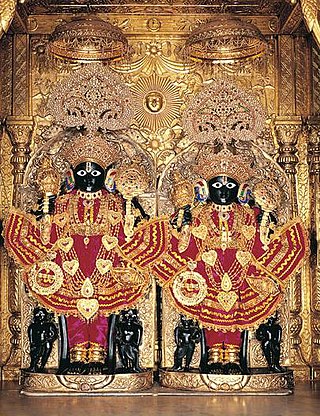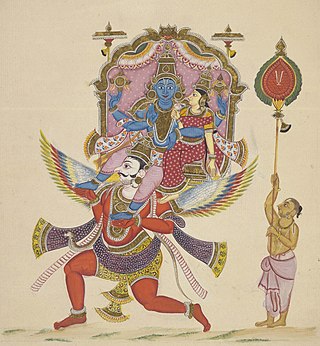
The Trimurti is the trinity of supreme divinity in Hinduism, in which the cosmic functions of creation, preservation, and destruction are personified as a triad of deities. Typically, the designations are that of Brahma the creator, Vishnu the preserver, and Shiva the destroyer. The Om symbol of Hinduism is considered to have an allusion to Trimurti, where the A, U, and M phonemes of the word are considered to indicate creation, preservation and destruction, adding up to represent Brahman. The Tridevi is the trinity of goddess consorts for the Trimurti.

Narada, or Narada Muni, is a sage-divinity, famous in Hindu traditions as a travelling musician and storyteller, who carries news and enlightening wisdom. He is one of the mind-created children of Brahma, the creator god. He appears in a number of Hindu texts, notably the Mahabharata, telling Yudhishthira the story of Prahalada, and he also appears in the Ramayana and the Puranas. A common theme in Vaishnavism is the accompaniment of a number of deities such as Narada to offer aid to Vishnu upon his descent to earth to combat the forces of evil, or to enjoy a close view of epochal events. He is also referred to as Rishiraja, meaning the king of all sages. He was gifted with the boon of knowledge regarding the past, present, and the future.

Vaikuntha, also called Vishnuloka, and Tirunatu (Tirunāṭu) in Tamil, is the abode of Vishnu, the supreme deity in the Vaishnava tradition of Hinduism, and his consort, Lakshmi, the supreme goddess of the sect.

Madhvacharya, and also known as Purna Prajna and Ānanda Tīrtha, was an Indian philosopher, theologian and the chief proponent of the Dvaita (dualism) school of Vedanta. Madhva called his philosophy Tattvavāda meaning "arguments from a realist viewpoint".

Narayana is one of the forms and epithets of Vishnu. In this form, the deity is depicted in yogic slumber under the celestial waters, symbolising the masculine principle and associated with his role of creation. He is also known as Purushottama, and is considered the Supreme Being in Vaishnavism.

The Bhagavata tradition, also called Bhagavatism, refers to an ancient religious sect that traced its origin to the region of Mathura. After its syncretism with the Brahmanical tradition of Vishnu, Bhagavatism became a pan-Indian tradition by the second century BCE, according to R.C. Majumdar.

Naranarayana, also rendered Nara-Narayana, is a Hindu duo of sage-brothers. Generally regarded to be the partial-incarnation (aṃśa-avatara) of the preserver deity, Vishnu, on earth, Nara-Narayana are described to be the sons of Dharma and Ahimsa.

Ayyavazhi theology is the theology of a South Indian religious Faith and officially a sect of Hinduism known as Ayyavazhi. Several fundamental theological beliefs distinguish the Ayyavazhi tradition from Hinduism.

Pancharatra was a religious movement in Hinduism that originated in late 3rd-century BCE around the ideas of Narayana and the various avatars of Vishnu as their central deities. The movement later merged with the ancient Bhagavata tradition and contributed to the development of Vaishnavism. The Pancharatra movement created numerous literary treatises in Sanskrit called the Pancharatra Samhitas, and these have been influential Agamic texts within the theistic Vaishnava movements.
The following list consists of notable concepts that are derived from Hindu culture and associated cultures’ traditions, which are expressed as words in Sanskrit or other Indic languages and Dravidian languages. The main purpose of this list is to disambiguate multiple spellings, to make note of spellings no longer in use for these concepts, to define the concept in one or two lines, to make it easy for one to find and pin down specific concepts, and to provide a guide to unique concepts of Hinduism all in one place.

Lakshmi Narayana or Lakshmi Narayan is the dual representation of the Hindu deities Vishnu, also known as Narayana, and his consort, Lakshmi, traditionally featured in their abode, Vaikuntha. The goddess of prosperity and beauty, Lakshmi, is depicted as standing next to Vishnu, who holds the Panchajanya, Kaumodaki, Padma, and the Sudarshana Chakra. Another depiction of Lakshmi-Narayana portrays Lakshmi in the service of Narayana, who reclines on the cosmic serpent Shesha, floating in the Kshira Sagara, the Ocean of Milk.

Sandhyavandanam is a mandatory religious ritual centring around the recitation of the Gayatri mantra, traditionally supposed to be performed three times a day by Dvija communities of Hindus, particularly those initiated through the sacred thread ceremony referred to as the Upanayanam and instructed in its execution by a Guru, in this case one qualified to teach Vedic ritual. Sandhyopasana is considered as a path to attain liberation (moksha).

In Hinduism, the conception of God varies in its diverse religio-philosophical traditions. Hinduism comprises a wide range of beliefs about God and Divinity, such as henotheism, monotheism, polytheism, panentheism, pantheism, pandeism, monism, agnosticism, atheism, and nontheism.

Vaishnavism is one of the major Hindu denominations along with Shaivism, Shaktism, and Smartism. It is also called Vishnuism since it considers Vishnu as the sole supreme being leading all other Hindu deities, that is, Mahavishnu. Its followers are called Vaishnavites or Vaishnavas, and it includes sub-sects like Krishnaism and Ramaism, which consider Krishna and Rama as the supreme beings respectively. According to a 2010 estimate by Johnson and Grim, Vaishnavism is the largest Hindu sect, constituting about 641 million or 67.6% of Hindus.

Sad Vaishnavism, , is a denomination within the Vaishnavism—Bhagavata tradition of Hinduism. Sad Vaishnavism was founded by thirteenth century philosopher-saint Madhvacharya, who developed the Tattvavada (dvaita) Vedanta sub-school of Hindu philosophy.

Vishnu, also known as Narayana and Hari, is one of the principal deities of Hinduism. He is the supreme being within Vaishnavism, one of the major traditions within contemporary Hinduism.

The Uttaradi Math, is one of the main monasteries (matha) founded by Madhvacharya with Padmanabha Tirtha as its head to preserve and propagate Dvaita Vedanta (Tattvavada) outside Tulunadu region. Uttaradi Math is one of the three primary Dvaita monasteries or Mathatraya that descended from Madhvacharya in the lineage of Padmanabha Tirtha through Jayatirtha. After Jayatirtha and Vidyadhiraja Tirtha, Uttaradi Math continued in the lineage of Kavindra Tirtha and later in the lineage of Vidyanidhi Tirtha. The Moola Rama and Moola Sita idols worshipped in the Uttaradi Matha have a long history and are revered among adherents.

The Bhu Varaha Swamy temple is a Hindu temple, located at Srimushnam, in the South Indian state of Tamil Nadu. Constructed in the South Indian style of architecture, the temple is dedicated to Varaha, the boar-avatar of the god Vishnu and his consort Lakshmi as Ambujavalli Thayar. It is Classified one among the 108 Abhimana Kshethram of Vaishnavate tradition. One of the greatest Hindu scholars of Vaishnava Tattvavada (Dvaita) philosophy, Madhvacharya, have come and resided in this temple many times.
The Srimad Bhagavata is one of the main books of Hindu philosophy. The Bhagavata is a devotional account of the Supreme Being and His incarnations. The second book of the Srimad Bhagavata covers the creation of the universe according to Hindu Mythology and gives a summary of the Bhagavata. This book consists of 10 chapters. The Bhagavata is authored by Veda Vyasa and the source material for this summary is the translation presented by Swami Tapasyananda. Additional material and analysis is included.

The Kurmanathaswamy temple, also known as the Kurmanatha temple, Srikurma or Srikurmam temple, is a Hindu temple dedicated to Kurma – the second avatar of Vishnu. It is located in Srikurmam village, Srikakulam district in Andhra Pradesh, India. According to Prapannamrutam and earliest inscription of the temple, In saka 1035 CE Anantavarman Chodaganga Deva of Eastern Ganga Dynasty of Odisha converted this temple to a Vaishnava khetra from a Siva temple.The temple was Built before 11th-century AD in a fusion architecture of kalinga Architecture and Dravidian Architecture. The temple's perambulatory were constructed by Eastern Ganga Dynasty king Anangabhima Deva III , and it is dedicated to Vishnu as Kurmanathaswamy and his consort Lakshmi as Kurmanayaki. The temple has century old Orissan Pattachitra style mural paintings in side wall of pradakshina mandapa.
















